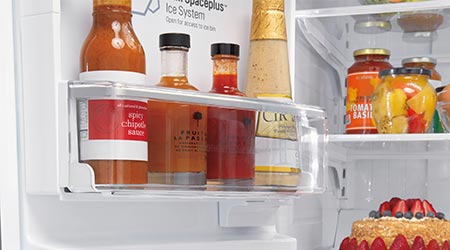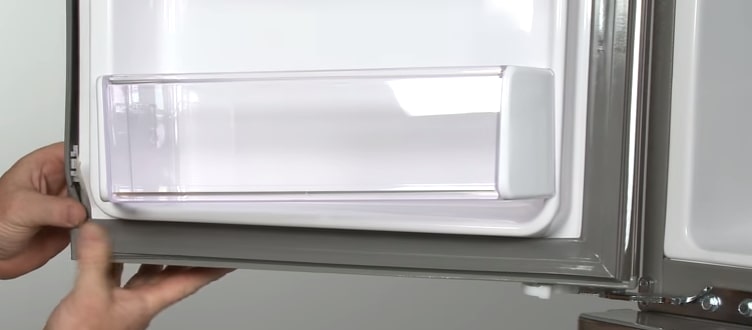At a Glance
Frost buildup inside the refrigerator occurs when warm, humid air from outside of the refrigerator combines with the cold, dry air on the inside.
LG refrigerators automatically defrosts every 4-16 hours which should resolve most frost buildup issues. If you don't want to wait you can manually defrost your refrigerator by following the steps below.
Try This
How to manually defrost your refrigerator
1 Unplug the unit and remove all food and ice from the ice bin.
2 Leave the doors open and wait at least 8 HOURS for the refrigerator to defrost.
3 Make sure to keep towels in and around the unit to soak up any excess water after the frost melts.
4 After 8 hours have passed, use a dry towel to remove any moisture that may be left inside the refrigerator and freezer.
5 Plug the unit back in, wait 24-48 hours for the refrigerator to return to normal operation.
6 Make sure the vents inside the refrigerator are not blocked, the refrigerator and doors are properly leveled, and the refrigerator and freezer doors are closed completely.
7 After the unit has automatically or manually defrosted, follow the steps below to prevent future frost buildup issues.
How to prevent frost buildup
1 Limit frequent opening of the door, and keep the freezing compartment correctly filled.
2 Reduce the amount of time the freezer is left open. This will help keep the temperature inside your freezer consistent and cold. You should always make sure the door is properly closed each time you use it.
3 Keep the freezer away from a hot water heater or furnace. Too much heat or cold can cause your freezer to work overtime, and the result is frost buildup.
4 Break up large packages into smaller, airtight packages. Smaller packages freeze better and make sure you dry each package before placing it in the freezer.
5 Clean your freezer seal (often referred to as a gasket) monthly by wiping it down with a soapy cloth. Add bleach if you see mold, and if it is ripped or torn, replace it.
6 Do not block your freezer's airflow by pushing it too close to the wall. The coils on (or in the back of) the freezer need some space to cool your freezer efficiently.
Troubleshooting Frost Buildup
Follow the troubleshooting steps to resolve and prevent frost buildup on your unit.
-
Do you see any error code on the display screen?
Yes No -
If you have any errors displaying on your refrigerator's display screen, visit our Error Codes - Refrigerator article.
-
Has a sheet of ice has formed at the bottom of the freezer?
Yes No -
If you notice a sheet of ice on the bottom/floor of your freezer, check your freezer door to ensure that it closes firmly.
-
Check door closure.
Most times, slight openings around the freezer door can allow enough moisture to enter into your unit which causes frost buildup.
Re-arrange food items that may be preventing the door from closing properly.
-
Blocked drain line.
If a sheet of ice has formed at the bottom of the freezer, this is likely caused by a blocked drain line.
Steps to take:
-
Manually defrost the unit Click here for manual defrost instructions. If a sheet of ice still forms on the floor of the freezer after a manual defrost, this indicates the drain line is blocked which will require a professional technician.
-
It is strongly recommended that a trained technician should perform the repair because it will require disassembling the refrigerator. Please visit our Request a Repair page for a professional service.
-
-
-
Frost buildup is mostly caused by simple issues such as leveling, doors not closing firmly, or items blocking the door/rails. Use the checklist below to identify where the frost is occurring and how to resolve it.
Frost buildup locations:
Most times, slight openings around the refrigerator/freezer doors can allow enough moisture to enter into the unit which causes frost buildup.
Steps to follow:
-
Make sure the right door (refrigerator) is pushed all the way closed.
-
Re-arrange your food items: Food items and beverages close to the front door may prevent the door from closing properly, which allows warm air to enter into your refrigerator/freezer.
-
Adjust the guide rails: Remove and reinsert the compartment drawer(s). When doing so, check if there are any items preventing the door from closing properly.

STEP 1. Remove the freezer door slightly from the guide rails.
STEP 2. Fully open and close the freezer door three times to reset the rail.
STEP 3. Close the freezer door firmly once the rails are adjusted properly.
-
How full is your refrigerator?
If the freezer is relatively empty, there is more air circulating, and a low temperature causes more of the excess air to freeze.
On the other hand, a tightly packed, full freezer can block the air vents, preventing proper air circulation that also causes frost buildup.
-
Current temperature setting
If the freezer's temperature is set too low, previous frost buildup may not able to fully melt during the automatic defrost cycle.
If the freezer temperature is set below 0oF, you may need to increase your temperature for at least 24 hours.
-
Check door closure.
Most times, slight openings around the freezer door can allow enough moisture to enter into your unit which causes frost buildup.
Re-arrange food items that may be preventing the door from closing properly.
-
Adjust the Guide Rails
Adjusting the guide rails: Remove and reinsert the compartment drawer(s). When doing so, check if there are any items preventing the door from closing properly.
STEP 1. Remove the freezer door slightly from the guide rails.
STEP 2. Fully open and close the freezer door three times to reset the rail.
STEP 3. Close the freezer door firmly once the guide rails are adjusted properly.
-
Check door closure.
Most times, slight openings around the freezer door can allow enough moisture to enter into your unit which causes frost buildup.
Re-arrange food items that may be preventing the door from closing properly.
-
Adjust the Guide Rails
Adjusting the guide rails: Remove and reinsert the compartment drawer(s). When doing so, check if there are any items preventing the door from closing properly.
STEP 1. Remove the freezer door slightly from the guide rails.
STEP 2. Fully open and closing the freezer door three times to reset the rail.
STEP 3. Close the freezer door firmly once the guide rails are adjusted properly.
-
Check the gasket.
-
Make sure that there are no items blocking the freezer door from shutting completely.
-
Be sure to check for items that may have fallen behind the drawers.
-
Visually inspect the door gasket to ensure that it's clean and there are no tears or rips.
-
If the gasket is dirty, use warm water and mild detergent to clean the gasket.
-
Make sure the gasket is properly connected to the liner and pull out any compressed part of the gasket.
 Note
NoteIf the gasket is ripped, torn, or twisted, you will need to request a repair service.
-
If you notice a sheet of ice on the bottom/floor of your freezer, check your freezer door to ensure that it closes firmly.
-
Check door closure.
Most times, slight openings around the freezer door can allow enough moisture to enter into your unit which causes frost buildup.
Re-arrange food items that may be preventing the door from closing properly.
-
Blocked drain line.
If a sheet of ice has formed at the bottom of the freezer, this is likely caused by a blocked drain line.
Steps to take:
-
Manually defrost the unit Click here for manual defrost instructions. If a sheet of ice still forms on the floor of the freezer after a manual defrost, this indicates the drain line is blocked which will require a professional technician.
-
It is strongly recommended that a trained technician should perform the repair because it will require disassembling the refrigerator. Please visit our Request a Repair page for a professional service.
-
-
Check door closure.
Most times, slight openings around the refrigerator/freezer door can allow enough moisture to enter into your unit which causes frost buildup.
Re-arrange food items that may be preventing the door from closing properly.
Make sure the right door (refrigerator) is pushed all the way closed.
Re-arrange your food items: Food items and beverages close to the front door may prevent the door from closing properly, which allows warm air to enter into your refrigerator/freezer.

-
Adjust the Guide Rails
Adjusting the guide rails: Remove and reinsert the compartment drawer(s). When doing so, check if there are any items preventing the door from closing properly.
STEP 1. Remove the freezer door slightly from the guide rails.
STEP 2. Fully open and close the freezer door three times to reset the rail.
STEP 3. Close the freezer door firmly once the guide rails are adjusted properly.
-
Proper leveling
Frost buildup can occur when the unit is not properly leveled,
The video below will walk you through properly leveling your refrigerator. Visit our Leveling Instructions for additional details.
-
Check door closure.
Most times, slight openings around the refrigerator doors can allow enough moisture to enter into your unit which causes frost buildup.
Re-arrange food items that may be preventing the door and ensure that the doors are closing properly.
Make sure the right door (refrigerator) is pushed all the way closed.
-
Check the gasket.
-
Make sure that there are no items blocking the freezer door from shutting completely.
-
Be sure to check for items that may have fallen behind the drawers.
-
Visually inspect the door gasket to ensure that it's clean and there are no tears or rips.
-
If the gasket is dirty, use warm water and mild detergent to clean the gasket.
-
Make sure the gasket is properly connected to the liner and pull out any compressed part of the gasket.
 Note
NoteIf the gasket is ripped, torn, or twisted, you will need to request a repair service.
-
-
Proper leveling
Frost buildup can occur when the unit is not properly leveled,
The video below will walk you through properly leveling your refrigerator. Visit our Leveling Instructions for additional details.
This is usually caused by frost that has melted or liquid that has been spilled inside the unit. Manually defrost and wipe up liquid at the bottom of the refrigerator.
It's normal for a small amount of frost to accumulate inside the refrigerator when the doors are open. The frost seen under the freezer basket is typically removed when the unit enters automatical defrost cycle.
NoteLG refrigerators AUTOMATICALLY defrosts every 4-16 hours which should resolve most frost buildup issues.
If you notice a sheet of ice on the bottom/floor of your freezer, check your freezer door to ensure that it closes firmly.
-
Check door closure.
Most times, slight openings around the freezer door can allow enough moisture to enter into your unit which causes frost buildup.
Re-arrange food items that may be preventing the door from closing properly.
-
Blocked drain line.
If a sheet of ice has formed at the bottom of the freezer, this is likely caused by a blocked drain line.
Steps to take:
-
Manually defrost the unit Click here for manual defrost instructions. If a sheet of ice still forms on the floor of the freezer after a manual defrost, this indicates the drain line is blocked which will require a professional technician.
-
It is strongly recommended that a trained technician should perform the repair because it will require disassembling the refrigerator. Please visit our Request a Repair page for a professional service.
-
-
Current temperature setting
If the freezer's temperature is set too low, previous frost buildup may not able to fully melt during the automatic defrost cycle.
If the freezer temperature is set below 0oF, you may need to increase your temperature for at least 24 hours.
-
Check door closure.
Most times, slight openings around the refrigerator doors can allow enough moisture to enter into your unit which causes frost buildup.
Re-arrange food items that may be preventing the door and ensure that the doors are closing properly.
Make sure the right door (refrigerator) is pushed all the way closed.
-
Check the gasket.
-
Make sure that there are no items blocking the freezer door from shutting completely.
-
Be sure to check for items that may have fallen behind the drawers.
-
Visually inspect the door gasket to ensure that it's clean and there are no tears or rips.
-
If the gasket is dirty, use warm water and mild detergent to clean the gasket.
-
Make sure the gasket is properly connected to the liner and pull out any compressed part of the gasket.
 Note
NoteIf the gasket is ripped, torn, or twisted, you will need to request a repair service.
-
-
Proper leveling
Frost buildup can occur when the unit is not properly leveled,
The video below will walk you through properly leveling your refrigerator. Visit our Leveling Instructions for additional details.
-
Current temperature setting
If the freezer's temperature is set too low, previous frost buildup may not able to fully melt during the automatic defrost cycle.
If the freezer temperature is set below 0oF, you may need to increase your temperature for at least 24 hours.
-
Check door closure.
Most times, slight openings around the refrigerator doors can allow enough moisture to enter into your unit which causes frost buildup.
Re-arrange food items that may be preventing the door and ensure that the doors are closing properly.
Make sure the right door (refrigerator) is pushed all the way closed.
-
Check the gasket.
-
Make sure that there are no items blocking the freezer door from shutting completely.
-
Be sure to check for items that may have fallen behind the drawers.
-
Visually inspect the door gasket to ensure that it's clean and there are no tears or rips.
-
If the gasket is dirty, use warm water and mild detergent to clean the gasket.
-
Make sure the gasket is properly connected to the liner and pull out any compressed part of the gasket.
 Note
NoteIf the gasket is ripped, torn, or twisted, you will need to request a repair service.
-
-
Proper leveling
Frost buildup can occur when the unit is not properly leveled,
The video below will walk you through properly leveling your refrigerator. Visit our Leveling Instructions for additional details.
-
Check door closure.
Most times, slight openings around the freezer door can allow enough moisture to enter into your unit which causes frost buildup.
Re-arrange food items that may be preventing the door from closing properly.
-
Adjust the Guide Rails
Adjusting the guide rails: Remove and reinsert the compartment drawer(s). When doing so, check if there are any items preventing the door from closing properly.
STEP 1. Remove the freezer door slightly from the guide rails.
STEP 2. Fully open and close the freezer door three times to reset the rail.
STEP 3. Close the freezer firmly once the guide rails are adjusted properly.
-
Check the gasket.
-
Make sure that there are no items blocking the freezer door from shutting completely.
-
Be sure to check for items that may have fallen behind the drawers.
-
Visually inspect the door gasket to ensure that it's clean and there are no tears or rips.
-
If the gasket is dirty, use warm water and mild detergent to clean the gasket.
-
Make sure the gasket is properly connected to the liner and pull out any compressed part of the gasket.
 Note
NoteIf the gasket is ripped, torn, or twisted, you will need to request a repair service.
-
-
Hot food in the unit.
Do not place hot items in the freezer. If you have freezing leftovers or hot food, wait until they have cooled to room temperature. This will prevent frost in the freezer and frost-bitten food.
-
Check door closure.
Most times, slight openings around the freezer door can allow enough moisture to enter into your unit which causes frost buildup.
Re-arrange food items that may be preventing the door from closing properly.
-
Adjust the Guide Rails
Adjusting the guide rails: Remove and reinsert the compartment drawer(s). When doing so, check if there are any items preventing the door from closing properly.
STEP 1. Remove the freezer door slightly from the guide rails.
STEP 2. Fully open and close the freezer door three times to reset the rails.
STEP 3. Close the freezer door firmly once the guide rails are adjusted properly.
-
Check the gasket.
-
Make sure that there are no items blocking the freezer door from shutting completely.
-
Be sure to check for items that may have fallen behind the drawers.
-
Visually inspect the door gasket to ensure that it's clean and there are no tears or rips.
-
If the gasket is dirty, use warm water and mild detergent to clean the gasket.
-
Make sure the gasket is properly connected to the liner and pull out any compressed part of the gasket.
 Note
NoteIf the gasket is ripped, torn, or twisted, you will need to request a repair service.
-
-
Hot food in the unit.
Do not place hot items in the freezer/refrigerator. If you have freezing leftovers or hot food, wait until they have cooled to room temperature. This will prevent frost in the freezer and frost-bitten food.
-
Check door closure.
Most times, slight openings around the refrigerator doors can allow enough moisture to enter into your unit which causes frost buildup.
Re-arrange food items that may be preventing the door and ensure that the doors are closing properly.
Make sure the right door (refrigerator) is pushed all the way closed.
-
Check the gasket.
-
Make sure that there are no items blocking the freezer door from shutting completely.
-
Be sure to check for items that may have fallen behind the drawers.
-
Visually inspect the door gasket to ensure that it's clean and there are no tears or rips.
-
If the gasket is dirty, use warm water and mild detergent to clean the gasket.
-
Make sure the gasket is properly connected to the liner and pull out any compressed part of the gasket.
 Note
NoteIf the gasket is ripped, torn, or twisted, you will need to request a repair service.
-
-
Hot food in the unit.
Do not place hot items in the freezer/refrigerator. If you have freezing leftovers or hot food, wait until they have cooled to room temperature. This will prevent frost in the freezer and frost-bitten food.
-
Check door closure.
Most times, slight openings around the refrigerator doors can allow enough moisture to enter into your unit which causes frost buildup.
Re-arrange food items that may be preventing the door and ensure that the doors are closing properly.
Make sure the right door (refrigerator) is pushed all the way closed.
-
Check the gasket.
-
Make sure that there are no items blocking the freezer door from shutting completely.
-
Be sure to check for items that may have fallen behind the drawers.
-
Visually inspect the door gasket to ensure that it's clean and there are no tears or rips.
-
If the gasket is dirty, use warm water and mild detergent to clean the gasket.
-
Make sure the gasket is properly connected to the liner and pull out any compressed part of the gasket.
 Note
NoteIf the gasket is ripped, torn, or twisted, you will need to request a repair service.
-
-
Fresh vegetables.
Vegetables with a high water content need to be at least room temp before adding to the drawers.
-
Check door closure.
Most times, slight openings around the refrigerator doors can allow enough moisture to enter into your unit which causes frost buildup.
Re-arrange food items that may be preventing the door and ensure that the doors are closing properly.
Make sure the right door (refrigerator) is pushed all the way closed.
-
Check the gasket.
-
Make sure that there are no items blocking the freezer door from shutting completely.
-
Be sure to check for items that may have fallen behind the drawers.
-
Visually inspect the door gasket to ensure that it's clean and there are no tears or rips.
-
If the gasket is dirty, use warm water and mild detergent to clean the gasket.
-
Make sure the gasket is properly connected to the liner and pull out any compressed part of the gasket.
 Note
NoteIf the gasket is ripped, torn, or twisted, you will need to request a repair service.
-
-
-
How to check leveling.
Frost buildup can occur when the unit is not properly leveled. The video below will walk you through properly leveling your refrigerator. Visit our Leveling Instructions for additional details.
-
How to fix door closure issues.
Most times, slight openings around the refrigerator/freezer doors can allow enough moisture to enter into the unit which causes frost buildup.
Steps to follow:
-
Make sure the right door (refrigerator) is pushed all the way closed.
-
Re-arrange your food items: Food items and beverages close to the front door may prevent the door from closing properly, which allows warm air to enter into your refrigerator/freezer.
-
Adjust the guide rails: Remove and reinsert the compartment drawer(s). When doing so, check if there are any items preventing the door from closing properly.

STEP 1. Remove the freezer door slightly from the guide rails.
STEP 2. Fully open and close the freezer door three times to reset the rail.
STEP 3. Close the freezer door firmly once the guide rails are adjusted properly.
-
-
How to food blocking the unit.












